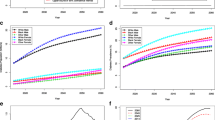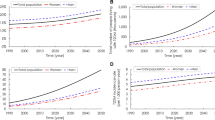Abstract
To estimate the number of persons in the age-group 55–74 years with type 2 diabetes in Germany until 2040 and to analyze the impact of an intervention in a high risk group. A Markov model is used to generate forecasts by age and sex in each year using inputs of estimated diabetes prevalence, incidence and mortality based on actual national data. Projections about future demographics stem from the German Federal Office of Statistics. In a slightly modified model a state for persons with prediabetes is included to study the interplay of effect-size and participation quote on the number of persons with diabetes. The projected number of people with type 2 diabetes aged 55–74 years rises from 2.4 million in 2010 to 3.9 million in 2030. From 2030 on this number will decrease slightly to 3.3 million in 2040. If every second person aged 55–74 with prediabetes took part in a prevention program with the effect size of the Finnish Diabetes Prevention Program, 0.4 million cases could be prevented until 2030. To prevent 1.0 million cases in 2030, 90 % of all persons with prediabetes had to take part in an intervention that reduces the transition rate from prediabetes to diabetes by 55 %. Unless enormous efforts are spent into prevention programs, the number of persons with type 2 diabetes will increase tremendously in the next two decades.





Similar content being viewed by others
Abbreviations
- IFG:
-
Impaired fasting glucose
- IGT:
-
Impaired glucose tolerance
- 95 % CI:
-
95 % confidence interval
- KORA:
-
Cooperative Health Research in the Region of Augsburg
References
Danaei G, Finucane MM, Lu Y, Singh GM, Cowan MJ, Paciorek CJ, et al. National, regional, and global trends in fasting plasma glucose and diabetes prevalence since 1980: systematic analysis of health examination surveys and epidemiological studies with 370 country-years and 2.7 million participants. Lancet. 2011;378(9785):31–40.
Sicree R, Shaw J, Zimmet R. The global burden: diabetes and impaired glucose tolerance. Background material for the IDF Diabetes Atlas. http://www.idf.org/diabetesatlas/downloads/backgroundpapers. Accessed 27 July 2011.
US Census Bureau. US Population Projections. http://www.census.gov/population/www/projections/index.html. Accessed 27 July 2011.
Office for National Statistics. National Population Projections. http://www.statistics.gov.uk/StatBase/Product.asp?vlnk=8519. Accessed 27 July 2011.
Federal Statistical Office of Germany. 12. Population Projection [12. Koordinierte Bevölkerungsvorausberechnung]. http://www.destatis.de. Accessed 27 July 2011.
Gillies CL, Abrams KR, Lambert PC, Cooper NJ, Sutton AJ, Hsu RT, Khunti K. Pharmacological and lifestyle interventions to prevent or delay type 2 diabetes in people with impaired glucose tolerance: systematic review and meta-analysis. BMJ. 2007;334(7588):299.
Sonnenberg FA, Beck JR. Markov models in medical decision making: a practical guide. Med Decis Mak. 1993;13:322–38.
Schipf S, Werner A, Tamayo T, Holle R, Schunk M, Maier W, Meisinger C, Thorand B, Berger K, Mueller G, Moebus S, Bokhof B, Kluttig A, Greiser KH, Neuhauser H, Ellert U, Icks A, Rathmann W, Völzke H. Regional differences in the prevalence of known type 2 diabetes mellitus in 45–74 years old individuals: results from six population-based studies in Germany (DIAB-CORE Consortium). Diabet Med. 2012;. doi:10.1111/j.1464-5491.2012.03578.x.
Rathmann W, Haastert B, Icks A, Löwel H, Meisinger C, Holle R, Giani G. High prevalence of undiagnosed diabetes mellitus in Southern Germany: target populations for efficient screening. The KORA survey 2000. Diabetologia. 2003;46:182–9.
Kowall B, Rathmann W, Heier M, Giani G, Peters A, Thorand B, Huth C, Icks A, Meisinger C. Categories of glucose tolerance and continuous glycemic measures and mortality. Eur J Epidemiol. 2011;26:637–45.
Lindström J, Ilanne-Parikka P, Peltonen M, Aunola S, Eriksson JG, Hämäläinen H, et al. Sustained reduction in the incidence of type 2 diabetes by lifestyle intervention: follow-up of the Finnish Diabetes Prevention Study. Lancet. 2006;368:1673–9.
Evans JMM, Barnett KN, Ogston SA, Morris AD. Increasing prevalence of type 2 diabetes in a Scottish population: effect of increasing incidence or decreasing mortality? Diabetologia. 2007;50:729–32.
Carstensen B, Kristensen JK, Ottosen P, Borch-Johnsen K. The Danish National Diabetes Register: trends in incidence, prevalence and mortality. Diabetologia. 2008;51:2187–96.
Tabák G, Herder C, Rathmann W, Brunner EJ, Kivimäki M. Prediabetes: a high-risk state for diabetes development. Lancet. 2012;379:2279–90.
Keiding N, Hansen BE, Holst C. Nonparametric estimation of disease incidence from a cross-sectional sample of a stationary population. Lect Notes Biomath. 1990;86:36–45.
Honeycutt AA, Boyle JP, Broglio KR, Thompson TJ, Hoerger TJ, Geiss LS, Narayan KM. A dynamic Markov model for forecasting diabetes prevalence in the United States through 2050. Health Care Manag Sci. 2003;6(3):155–64.
Boyle JP, Thompson TJ, Gregg EW, Barker LE, Williamson DF. Projection of the year 2050 burden of diabetes in the US adult population: dynamic modeling of incidence, mortality, and prediabetes prevalence. Popul Health Metr. 2010;22(8):29.
Baan CA, van Baal PH, Jacobs-van der Bruggen MA, Verkley H, Poos MJ, Hoogenveen RT, Schoemaker CG. Diabetes mellitus in the Netherlands: estimate of the current disease burden and prognosis for 2025. Ned Tijdschr Geneeskd. 2009;153:A580. (Dutch).
Conflict of interest
None.
Author information
Authors and Affiliations
Corresponding author
Electronic supplementary material
Below is the link to the electronic supplementary material.
Rights and permissions
About this article
Cite this article
Brinks, R., Tamayo, T., Kowall, B. et al. Prevalence of type 2 diabetes in Germany in 2040: estimates from an epidemiological model. Eur J Epidemiol 27, 791–797 (2012). https://doi.org/10.1007/s10654-012-9726-2
Received:
Accepted:
Published:
Issue Date:
DOI: https://doi.org/10.1007/s10654-012-9726-2




